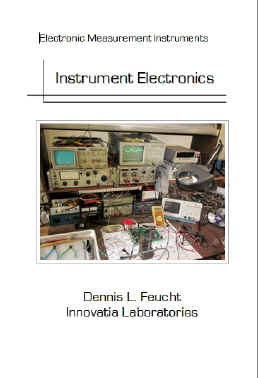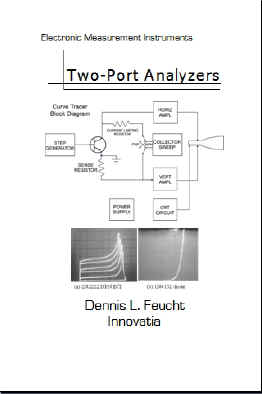

A 432-page book onAmplifier CircuitsThe first part of this book presents basic engineering principles of transistor circuit analysis for design by limiting the analysis to quasistatics. The complications of dynamics are introduced in the second part of the book. Emphasizing simplified thinking about analog circuits through intuitive explanations of the mathematics, design equations are derived and interpreted in terms of the circuits. The basic circuits, beginning with the three transistor configurations, then two-transistor combinations, are explained in detail. Feedback is covered more thoroughly than in textbooks, including how to go from circuit to feedback block diagram. Multi-path circuits, such as BJTs and FETs with ro are included.The second part of the book introduces reactances and amplifier transient and frequency response, continuing the emphasis on design. Dynamic circuit compensation is one of three chapters. The third is about an important circuit behavior largely unexplained elsewhere, that of amplifier behavior in the region between bandwidth and fT, where impedances gyrate and spurious oscillations can occur. References and an index are included.This third edition book combines and refines the first two books of the second edition. |
A 342-page book onHigh-Performance AmplifiersBuilding on what is in Amplifier Circuits, this book presents some of the advanced circuit techniques used in high-bandwidth measurement instruments such as inductive peaking, emitter compensation, and bootstrapping speed-improvement circuits. Not only is wideband amplification covered, with fast circuit design not found in most analog circuits books, but high performance also includes precision circuits found in DMMs, Z meters, distortion analyzers, and source-measure units. Thermal and noise considerations include methods of design that minimize their effects. Complementary emitter-follower output stages and current-feedback amplifiers are covered in detail. So are isolation amplifiers, translinear multipliers, gain-switched amplifiers, and the statistics of error tolerance, applied to circuit design. The final chapter reveals circuits that are both fast and precise, found in measurement instruments such as oscilloscope vertical amplifiers. These include current-input and current-feedback amplifiers, split-path schemes, feedforward and linearized differential cascode amplifiers, a-compensated gain cells, translinear circuits, fT multipliers, and high-performance buffer amplifiers.This third-edition book greatly expands and refines the contents of the previous editions. References and an index are included. |
A 222-page book onWaveform-Processing CircuitsThis book goes beyond amplifiers to include other analog waveform-processing circuits. It begins with detailed solid-state electronics of bandgap voltage references, then current sources. A library of analog circuits presented from a design standpoint include peak detectors, timing circuits, including high-speed triggering circuits in oscilloscopes, log and exponential function generation, including translinear squarers, square-root, and root-sum-of-squares circuits, absolute-value circuits, some basic filters, hysteretic comparators, clamps, and limiters, and ramp, sweep, and triangle-wave generators as found in function generators.The second part of the book presents time- and frequency-domain sampling theory, sample and hold circuits, but begins with D/A and A/D conversion, including V/F and sigma-delta circuits based on simple microcomputer interfacing. References and an index are included. |
A 486-page book onTransistor AmplifiersFinally! A book that gives the details of engineering thinking for the design of some 2- to 6-transistor amplifier circuits. The circuits look simple at first, but as the design proceeds to deeper layers of complexity, the design considerations become more advanced. Yet all that is mostly needed to follow these design walk-throughs is algebra, a calculator, and an active mind.Furthermore, the book contains lesser-known circuit theorems and a much-neglected topic: amplifier behavior above bandwidth, where resistance becomes inductive and resonates with capacitance. Bandwidth estimation is also developed, based on open- and short-circuit time constants. Index included. |
An 86-page book onCircuit DynamicsDesign-Oriented AnalysisThis short book presents in detail the theoretical foundation of dynamic transistor circuit analysis in the time and frequency domains. It supplements what is found in Transistor Amplifiers and Amplifier Circuits by beginning with the step by step development of the theory. It goes beyond engineering textbooks by presenting more realistic circuits as encountered in commercial products. Once the derivations are worked out - and some of them are algebraically involved - they can be used as templates for circuit design. They also give insights into how the circuits behave, as the equations are interpreted by how they relate to the circuits.This book is intended to take some of the mystery out of what is often a difficult aspect of circuit analysis and design. It is for those seeking a better, clearer understanding of what is too extensive to put into active-circuits textbooks. |
A 466-page book onPower Magnetics Design OptimizationThis is the first book of the series on power electronics and a precursor to the next four books on power converters.The design of power magnetics components is mysteriously complicated to even many power-electronics engineers. This book is not a rehash of prior magnetics textbooks, but presents instead new perspectives on magnetics, new methods, and clarified theory. What is new in this book?The back cover explains.Index, table of symbols, and Mathcad program list is included. |
A 1085-page book in 4 partsPower Converter Design OptimizationThis is the second book of the series on power electronics design optimization, introducing new converter design concepts.Major topics in four Parts are types of converters, their circuits, parasitic resonances and feedback control, and the design of PFCs and inverters.Resistance Converters 390 pagesConverter Circuits 256 pagesConverter Dynamics 296 pagesWaveshape Converters 143
pages
|
 |
A 348-page book onInstrument ElectronicsThis is the first book of the series on electronic measurement instruments. It covers both the general topics of instrument architecture and also common circuits and software algorithms found in many measurement instruments.A general block diagram representing any microcomputer-based instrument is developed as a guide to instrument design, including both electronics and software.The inclusion of AI concepts in instruments is covered in the context of instrument automated diagnostic capabilities, where some of the knowledge of an instrument user is placed in the instrument. |
 |
A 278-page book onTwo-Port AnalyzersOtherwise known as transistor parameter analyzers (H-P) or curve tracers (Tek), TPAs are two or more source-measure units (SMUs) coordinated in their functions of measuring one or two (or more) port parameters of devices or any other ported circuit.TPAs measure and compute such device parameters as BJT b, ro, base or collector voltages or currents, FET IDSS , VTH , or rm.SMU driver circuits coverage emphasizes how to compensate for voltage-current measurement interactions at the port.Some of the TPAs in the Innovatia 200 series are analyzed in detail. |
A 242-page book onImpedance Meters and AnalyzersImpedance meters (ZMs) or RLC meters extend beyond ohmmeter measurement of resistance to include reactances. A reactance value is measured by driving it with a sine-wave, measuring voltage and current, then computing inductance or capacitance. Impedance analyzers (ZAs) extend ZM capabilities by allowing the drive frequency to be swept to generate impedance-frequency plots.ZMs have multiple design alternatives, and they are covered in this book, along with the various engineering derivations of design formulas used to design ZMs and ZAs.Included is coverage of some Innovatia 200-series ZMs and a ZA. |
A 344-page book onGenerators: Pulse, Function and WaveformGenerators are waveform sources, categorized as pulse, function, or waveform, where waveform generators digitally generate waveforms. The basic design considerations of these kinds of generators is covered, along with the derivation of design formulas and their application.PG high and low level processing for setting offset and amplitude involves multipliers. Analog level processors are covered.Additional chapters cover the Tektronix PF508 and various Innovatia 200-series PGs including a 5 A power pulser. Multiple Innovatia FG2xx generators are also described.Sine generators are omitted and found in the impedance meters book. |
A 216-page book onRocketry and AstrionicsThis book combines coverage of rocket fundamentals: flight mechanics and trajectory simulation in Mathcad (with drag, standard atmosphere, gravity turn), propulsion, nozzle shape optimization, injectors and manifolds, recovery and staging, tank design, ground support, and launch procedures.The rocket electronics, or astrionics includes valve controllers, igniters and pyrotechnic actuators, and data-acquisition systems, with sensors and data processing, including computer two-point calibration.The emphasis in this book is on liquid-propellant rocket structure and component design, instrumentation and control, ground support, and launch procedure. Basic feedback control principles support guidance. Vector thrust control equations are derived.The book ends with a case study of a 21-foot (6.4 m) 1000 lbf thrust LOX-kerosene rocket, showing some of the details involved in a sounding-rocket project.Those working on aerospace systems can benefit from an understanding of the basic principles of rocketry, and this book provides a "jump-start" for those seeking to do electronics in an aerospace environment. |